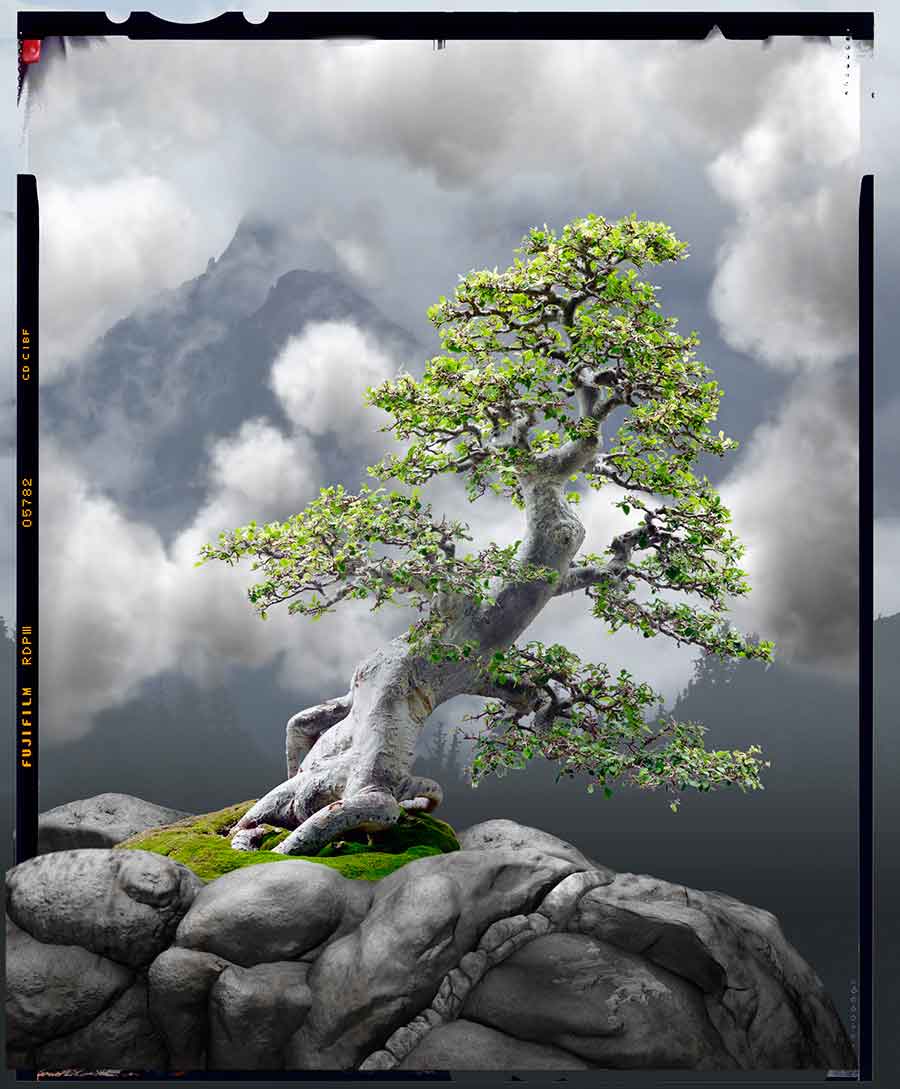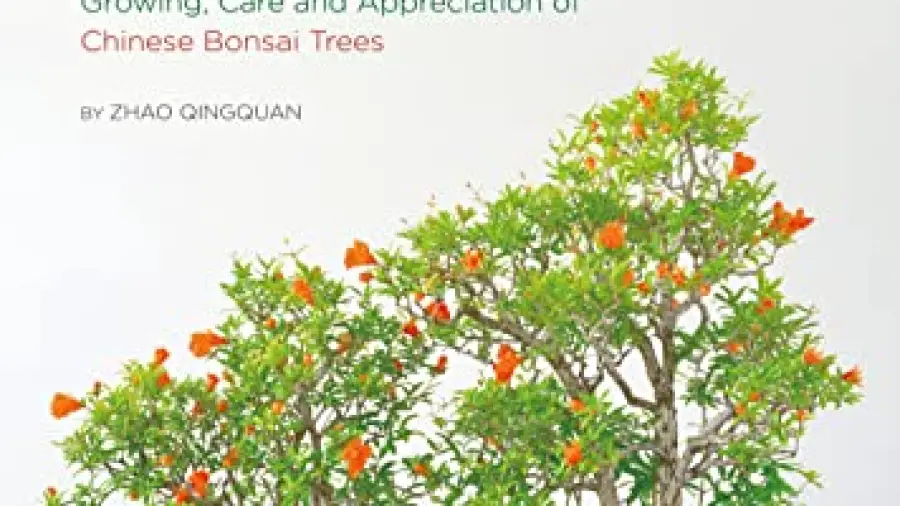Bonsai on Rock, known as “Seki-joju” or “Ishisuki,” artfully marries plants with stones. It involves arranging bonsai trees to grow with their roots embracing the rock.
Gardeners and bonsai enthusiasts often seek to mimic the dynamic relationships found in nature by creating Bonsai on Rock arrangements. This traditional Japanese art form requires selecting the right rock with ample pockets and crevices for the tree’s roots to latch onto and flourish.
Bonsai on Rock Mastery: The rock not only becomes the foundation of the display but also contributes to the overall aesthetic, often symbolizing ruggedness and endurance. These bonsai displays can stand out both indoors and outdoors, making them versatile additions to any collection. Proper care, including frequent watering and maintenance, is essential due to the limited soil available to the plant’s roots. Crafting such a living sculpture takes skill and patience, as one must ensure the tree’s roots are secure and its growth is steady over the rock surface. As a dramatic presentation of resilience and harmony, Bonsai on Rock embodies a powerful natural scene in a miniature form.
Table of Contents

Credit: yugenbonsai.com
The Ancient Art Of Bonsai
Bonsai, a timeless art form, finds its roots deep in Asian culture. Craftsmen would shape trees to mirror nature’s beauty. Bonsai on Rock simulates trees growing on rocky terrains. Tiny trees cling to life on stunning stones, telling tales of survival.
| Bonsai Style | Description |
|---|---|
| Ishizuki | Trees that grow on or through rocks. |
| Ikadabuki | Tree trunks lay side by side, mimicking a forest floor. |
| Kengai | Known as cascade, the form droops as if from a cliff. |
| Shakan | Focused on trees leaning in one direction, often due to winds. |
Each style depicts a unique struggle or aspect of nature. Far from mere decorations, these living sculptures reflect strength, balance, and aesthetic grace.
Bonsai On Rock Fundamentals
Bonsai on Rock Fundamentals delve into the unique art of blending nature with earthen sculpture. Seki-joju and Ishisuki present two distinct styles of this practice.
Seki-joju, also known as the root-over-rock style, showcases trees with roots flowing over a rock. These roots eventually reach the soil below. In contrast, Ishisuki involves the tree growing within the crevices of rocks where the soil is less, meaning water and nutrients are scarce.
Choosing the correct combination of rock and tree species is vital for a successful Bonsai on Rock creation. Hardy trees like pines and junipers are often favored for their resilience. Similarly, the rock should be porous to enable the tree’s roots to hold firmly. It must also withstand weathering to ensure the longevity of the landscape art.
Bonsai on Rock Mastery: Selecting The Perfect Stone
A perfect rock should be durable and able to withstand weather conditions. Texture is crucial, as it adds natural beauty and interest. Holes and crevices allow bonsai roots to grip securely.
The rock’s color should complement the bonsai. Size and shape must balance with the tree. A rock that is too small may not hold the tree well.
Collect rocks from rivers or purchase from garden centers. Sanitize them with mild bleach solution. Rinse thoroughly and let dry before use.

Credit: huntington.org
Designing The Miniature Landscape
Bonsai on Rock combines living plants with rocks, creating a small landscape. This art form needs a good eye for design. You must place the tree and roots so they look nice and stay healthy. Trees grow well when roots spread evenly around the rock. Root placement is key. Roots should wrap the rock tightly. They must also get enough soil to reach for water and food.
The roots and rock must look natural together. Use a rock with holes and grooves. These help hold soil and roots in place. Your bonsai tree should mimic a real landscape. Think about where trees grow on rocks in nature. This will guide you in creating a beautiful miniature landscape.
Remember, the tree’s size should fit the rock. This balance makes the whole scene look right. Your bonsai on rock will then be a tiny slice of nature.
Crafting Techniques
To secure the tree to the rock, use safe methods. Tie the roots with a soft wire, and cover them with soil. This encourages the tree to cling to the rock as it grows.
For the training roots over rock, patience is key. Begin by extending the roots across the rock. Keep them moist and use a mix of clay and moss to protect them. Over time, roots will naturally follow the contour of the rock.
Soil And Substrate
Creating a successful Bonsai on a rock setup requires a special mix of components. This mix supports plant health and secures the tree to the rock. Basic ingredients include Akadama, pumice, and fine gravel. These allow for strong drainage and encourage healthy root growth. Each component plays a key role. Akadama helps retain water, pumice aerates the soil, and fine gravel ensures stability.
For optimal growth, roots need air and water. The mixture must not be too dense, as this can suffocate the roots. Make sure to mix thoroughly before placing it on the rock. The final consistency should feel gritty and loose. This helps the roots cling to the rock and absorb nutrients efficiently.
Long-term Care
Watering nuances for rock plantings demand consistent attention. Use early morning or late afternoon sessions for best results. Temperatures are cooler, reducing evaporation. Aim for mildly damp soil, never soggy. Mist the foliage frequently to mimic natural humidity.
Seasonal maintenance routines ensure year-round beauty. Spring calls for pruning and inspecting root health. Summer emphasizes frequent watering to combat heat. Fall is for prepping bonsai for cooler temps. Winter requires protection from frost. A stable maintenance routine preserves the artful rock planting.
Creative Inspirations
Creating beautiful bonsai on rock displays blends art with nature. Each piece tells its own story, showcasing tiny trees growing against the odds. Start by choosing a sturdy rock that complements the bonsai.
Select plants with flexible roots for easier wrapping around the rock. Junipers and Ficus species are popular choices for their adaptability. Craft a sustainable environment for your bonsai. This will ensure growth and health.
| Rock Type | Bonsai Type | Care Tips |
|---|---|---|
| Lava Rock | Ficus | Moisture Retention |
| Sandstone | Juniper | Drains Well |
| Granite | Pine | Withstands Weather |
To expand your bonsai rock garden, mix different species and rocks. This creates diverse visual appeal. Secure your bonsai for optimal support. Engage in regular maintenance to shape and direct growth.
Common Challenges
Bonsai on Rock cultivation brings a unique challenge of maintaining the health and aesthetics of these miniature trees. One significant aspect to consider is disease and pest management. A proactive approach involves regular inspections for early detection of issues.
Simple strategies include isolation of new plants to prevent spread and removal of affected areas when problems are noticed. Using organic pesticides can be advantageous for safety and environmental reasons. Consistency plays a key role in preventing large-scale infestations within your collection.
Ensuring a balanced watering routine and providing adequate sunlight and air circulation are essential to discourage common problems. Healthy soil mixtures tailored to bonsai can also prevent many disease and pest issues.
Bonsai And Zen
The art of Bonsai on Rock is deeply rooted in Zen philosophy. Tiny trees perched atop rugged stones offer a miniature landscape for reflection. The combination symbolizes harmony between living trees and inanimate rocks. This meditative practice encourages patience and calm focus. It reflects the balance between nature and the human touch.
Creating rock bonsai, also known as root over rock, involves training the tree’s roots to wrap around a rock. This represents the tree’s struggle and triumph in nature. Each piece is unique, with its tree and stone telling a silent story. Practitioners find solace in tending to these creations, connecting with the natural world.
Showcasing Your Work
Bonsai rock creations are truly mesmerizing. Displaying them sparks curiosity and awe. The key is choosing a strong and stable rock as a base. Your bonsai will thrive atop these unique foundations. To best present your work, ensure proper light and angles are in place. This highlights the sculptural beauty of the miniature tree.
To engage with others who appreciate these art forms, join local or online bonsai communities. Share your projects and learn from others. Exchange tips on care and display. These interactions can lead to new inspiration and growth in your bonsai journey.
Choose your platform: local clubs, online forums, or social media groups. Each has its unique way of fostering connections and expanding your skills.
- Local Clubs: In-person workshops and exhibits.
- Online Forums: A wealth of information and advice.
- Social Media: Instant feedback and global reach.

Credit: www.amazon.com
Advancing Your Skills
Participating in workshops and courses boosts your bonsai creation skills. Experts teach you the craft of shaping tiny trees against rocks.
Engage with master bonsai artists. They show you the secrets to selecting the perfect rock and matching it with a tree. This is key for a stunning Bonsai on Rock display.
Hands-on experience is invaluable. Direct guidance helps you understand the growth pattern of roots over rocks. Skills in wiring and pruning also improve.
These educational sessions are open to all levels. Beginners, as well as advanced enthusiasts, can benefit significantly. So, to enhance your craft, consider signing up!
Frequently Asked Questions For Bonsai On Rock
Can You Grow Bonsai On A Rock?
Yes, you can grow bonsai on a rock through techniques like root-over-rock, where tree roots wrap around the rock.
What Is Best Bonsai Over Rock?
The best bonsai over rock is the Ficus species, particularly ‘Green Island’ Ficus for its adaptability and root display.
What Rocks To Use For Bonsai?
Use rocks with small cracks and holes like lava rock, or alternatively, porous stones that retain moisture to support bonsai growth.
What Is The One To Six Rule Of Bonsai?
The one to six rule of bonsai refers to maintaining a proportional balance, with one part bonsai tree to six parts pot.
Conclusion
Embracing the art of bonsai on rock can transform your gardening experience. By focusing on the natural beauty of miniature trees and rugged stones, you create living sculptures unmatched in uniqueness. Remember, patience is vital as your bonsai’s roots slowly embrace its rocky partner.
Whether a seasoned practitioner or a curious beginner, bonsai on rock is an intriguing venture worth exploring. Now, take this inspiration and let your own bonsai journey begin!
